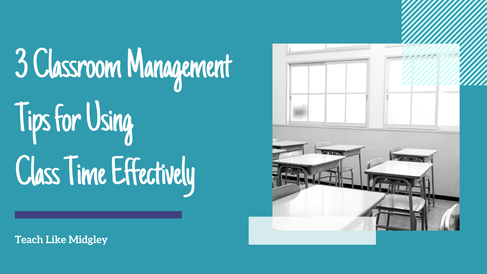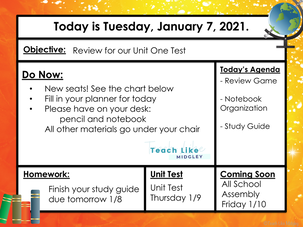3 Classroom Management Tips for Using Class Time Effectively
I don’t know about you, but it seems that I am constantly fighting for my instruction time.
Whether it’s assemblies, school photos, testing, surveys, or mandatory items from administration. There always seems to be something that is trying to take away my time to teach.
It seems at almost every staff meeting there is a topic or activity brought up that directly affects my instruction time.
And it seems I am always saying No.
Not because I’m not a team player. Not because I want to be the bad guy.
Not because I don’t care.
No. Because I need my instruction time.
No. Because my time with my students is valuable and I don’t want to waste it.
The response I’ve received is almost shocking – my administrator doesn’t understand. In fact, my administrator has claimed they witness wasted class time by teachers every day.
What? Wait a minute there.
I say, Surely you are not witnessing wasted time in MY classroom...
And I am reassured that is not the case. Yet the statement stands true in 90% of the classrooms in the school.
And it dawns on me – some teachers are not effective at transitions. And I think perhaps I can help share some techniques I’ve learned to help me effectively use my class time.
Management Tip: Know What You're Doing
As the teacher, you better know what you’re doing. If you start the day off on a whim, then you are no doubt wasting valuable time.
Never leave school without knowing what you are teaching the next day. In fact, go one step farther and have your classroom set up for the next day’s lesson before you leave school.
This includes, but is not limited to:
- Seating Arrangements. What type of lesson are you conducting? How are students working? How should their desks be arranged?
- Materials. What materials do the students need for the activity? What papers will you need to pass out? What tools do you need for presenting to students?
- Teacher Organization. In addition to thinking ahead about what the students need, what do you need? Have your materials/supplies lined up and ready. This includes your notes, manuals, projector, etc.
Never leave school without knowing what you are teaching the next day. In fact, go one step farther and have your classroom set up for the next day’s lesson before you leave school.
This includes, but is not limited to:
- Seating Arrangements. What type of lesson are you conducting? How are students working? How should their desks be arranged?
- Materials. What materials do the students need for the activity? What papers will you need to pass out? What tools do you need for presenting to students?
- Teacher Organization. In addition to thinking ahead about what the students need, what do you need? Have your materials/supplies lined up and ready. This includes your notes, manuals, projector, etc.
Management Tip: Directions on the Board
I use painters tape to section off part of the white board. The painters tape lasts the school year, and doesn’t leave residue behind. But make sure you get the real stuff - there's a lot of colored tape out there! This is the brand I use. Do NOT use duct or masking tape – your custodians will not be happy with you!
Another great option is to project a digital version. This is also great for traveling teachers or if you just want to have everything written out ahead of time. Check out these done-for-you PowerPoint slides.
Students enter, and immediately begin on the Do-Now Work (hence, the name!)
Do-Now Work includes:
First – where to sit
(same, previously assigned seats or see the new seating chart, etc)
Second – take out/turn in homework, if applicable
Third – materials needed for the lesson – such as textbook, notebook, ruler, highlighter, etc. Anything needed that students don’t have, is on a table for them to pick it up, located under the board’s directions.
Finally – and perhaps one of the most important pieces to this tip:
Please place the rest of your belongings UNDER YOUR CHAIR.
(I'll come back to this one in a minute!)
Do-Now Work may also include other instructions, such as: reading a particular textbook passage, reviewing the previous day’s notes, filling in the Table of Contents for their Student Notebook for the day’s lesson (once they’ve been trained how), or take 5 minutes to review material before a quiz, or a “think about” question that relates to our upcoming lesson...
As you can see, there are lots of options here. Another part of the class procedure, is for students to use the time to fill in their planner with the day’s assignment.
While many teachers assign Bell Work or Warm up Questions (which can be included here), I find this class procedure to be very effective and efficient.
So, why do I have students place their belongings under their chairs?
#1 - It keeps things out of the walkway so nobody trips or steps on things.
#2 - It gives students room to work on their desktops.
#3 - It helps eliminate distractions.
Another benefit to this procedure, is that it sets the tone for what behavior is acceptable in your classroom.
My classroom is a place to focus, learn, and help others learn. There is no room for horse-play. This procedure helps me to establish this expectation.
In addition, on the off chance I am delayed for some reason, my students are fully capable of entering my classroom and getting started without me.
Another great option is to project a digital version. This is also great for traveling teachers or if you just want to have everything written out ahead of time. Check out these done-for-you PowerPoint slides.
Students enter, and immediately begin on the Do-Now Work (hence, the name!)
Do-Now Work includes:
First – where to sit
(same, previously assigned seats or see the new seating chart, etc)
Second – take out/turn in homework, if applicable
Third – materials needed for the lesson – such as textbook, notebook, ruler, highlighter, etc. Anything needed that students don’t have, is on a table for them to pick it up, located under the board’s directions.
Finally – and perhaps one of the most important pieces to this tip:
Please place the rest of your belongings UNDER YOUR CHAIR.
(I'll come back to this one in a minute!)
Do-Now Work may also include other instructions, such as: reading a particular textbook passage, reviewing the previous day’s notes, filling in the Table of Contents for their Student Notebook for the day’s lesson (once they’ve been trained how), or take 5 minutes to review material before a quiz, or a “think about” question that relates to our upcoming lesson...
As you can see, there are lots of options here. Another part of the class procedure, is for students to use the time to fill in their planner with the day’s assignment.
While many teachers assign Bell Work or Warm up Questions (which can be included here), I find this class procedure to be very effective and efficient.
So, why do I have students place their belongings under their chairs?
#1 - It keeps things out of the walkway so nobody trips or steps on things.
#2 - It gives students room to work on their desktops.
#3 - It helps eliminate distractions.
Another benefit to this procedure, is that it sets the tone for what behavior is acceptable in your classroom.
My classroom is a place to focus, learn, and help others learn. There is no room for horse-play. This procedure helps me to establish this expectation.
In addition, on the off chance I am delayed for some reason, my students are fully capable of entering my classroom and getting started without me.
Management Tip: Starting & Ending Class
According to my administrator, the first and last 10 minutes of class periods are often wasted by teachers.
If you effectively teach the Directions on the Board class procedure, you should be able to start your class almost immediately.
While this hack works very well in the secondary world, I also used it when I taught in the elementary setting.
When the bell rings to start class, I close the door and immediately greet my students and launch into the day’s activities.
If I need to collect something from students, I will ask the class review questions as I do.
Related: Collecting Homework and Keeping Students Accountable
I always start class with what we’ve learned so far, before launching a new lesson.
It is easy to see how starting the class period can be slow moving if the teacher and students are unprepared. But what about the end of class?
It seems efficient lesson planning is also key in effectively using your class time. If you don’t have enough for students to do, then they will often pack up early and waste their time.
You also don’t want to try and cram in too much. This can cause student stress at the end of the period when they know they need to pack up and book it to the other end of the school for their next class.
In order to maintain efficient use of time and not stress my students, I established another end-of-class procedure: The 2 Minute Clean Up.
I always wrap up my lesson and give my students the last 2 minutes to pack up their things. They are also permitted to push in their chairs and stand behind them with their belongings in hand until the bell rings.
This helps alleviate their stress of being on time to their next class and helps them focus during my lesson, knowing I’m not going to go over on time.
If you effectively teach the Directions on the Board class procedure, you should be able to start your class almost immediately.
While this hack works very well in the secondary world, I also used it when I taught in the elementary setting.
When the bell rings to start class, I close the door and immediately greet my students and launch into the day’s activities.
If I need to collect something from students, I will ask the class review questions as I do.
Related: Collecting Homework and Keeping Students Accountable
I always start class with what we’ve learned so far, before launching a new lesson.
It is easy to see how starting the class period can be slow moving if the teacher and students are unprepared. But what about the end of class?
It seems efficient lesson planning is also key in effectively using your class time. If you don’t have enough for students to do, then they will often pack up early and waste their time.
You also don’t want to try and cram in too much. This can cause student stress at the end of the period when they know they need to pack up and book it to the other end of the school for their next class.
In order to maintain efficient use of time and not stress my students, I established another end-of-class procedure: The 2 Minute Clean Up.
I always wrap up my lesson and give my students the last 2 minutes to pack up their things. They are also permitted to push in their chairs and stand behind them with their belongings in hand until the bell rings.
This helps alleviate their stress of being on time to their next class and helps them focus during my lesson, knowing I’m not going to go over on time.
You May Also Like...
Let's Connect...

Welcome! I'm Hillary Midgley, a veteran 6th grade teacher.
I create educational materials and develop curriculum for other teachers. I specialize in teaching students how to learn through my Study Skills Curriculum. I have established fundamental classroom systems and structures for teachers to help them streamline their classroom. And my passion is teaching ancient history through engaging activities with foundations in academic skills. Here you will find resources on all of these topics and more. Learn more about me here.
|







